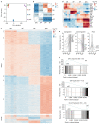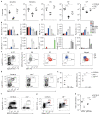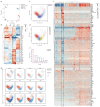Distinct progenitor lineages contribute to the heterogeneity of plasmacytoid dendritic cells
- PMID: 29925996
- PMCID: PMC7614340
- DOI: 10.1038/s41590-018-0136-9
Distinct progenitor lineages contribute to the heterogeneity of plasmacytoid dendritic cells
Abstract
Plasmacytoid dendritic cells (pDCs) are an immune subset devoted to the production of high amounts of type 1 interferons in response to viral infections. Whereas conventional dendritic cells (cDCs) originate mostly from a common dendritic cell progenitor (CDP), pDCs have been shown to develop from both CDPs and common lymphoid progenitors. Here, we found that pDCs developed predominantly from IL-7R+ lymphoid progenitor cells. Expression of SiglecH and Ly6D defined pDC lineage commitment along the lymphoid branch. Transcriptional characterization of SiglecH+Ly6D+ precursors indicated that pDC development requires high expression of the transcription factor IRF8, whereas pDC identity relies on TCF4. RNA sequencing of IL-7R+ lymphoid and CDP-derived pDCs mirrored the heterogeneity of mature pDCs observed in single-cell analysis. Both mature pDC subsets are able to secrete type 1 interferons, but only myeloid-derived pDCs share with cDCs their ability to process and present antigen.
Conflict of interest statement
The authors declare no competing interests.
Figures








Comment in
-
Plasmacytoid dendritic cells: origin matters.Nat Immunol. 2018 Jul;19(7):652-654. doi: 10.1038/s41590-018-0143-x. Nat Immunol. 2018. PMID: 29925994 No abstract available.
References
-
- Banchereau J, Steinman RM. Dendritic cells and the control of immunity. Nature. 1998;392:245–252. - PubMed
-
- Colonna M, Trinchieri G, Liu YJ. Plasmacytoid dendritic cells in immunity. Nat Immunol. 2004;5:1219–1226. - PubMed
-
- Mildner A, Jung S. Development and function of dendritic cell subsets. Immunity. 2014;40:642–656. - PubMed
Publication types
MeSH terms
Substances
Grants and funding
LinkOut - more resources
Full Text Sources
Other Literature Sources
Medical
Molecular Biology Databases
Research Materials

